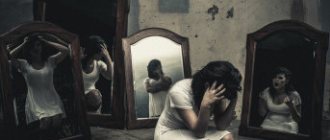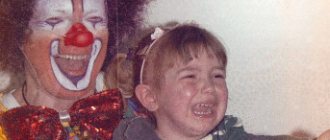Fear is a human emotion that has gone through quite a long evolutionary path. In historical times, he helped people avoid danger that could overtake them. Now fear accompanies the human head every day: losing a phone, money, being called to the authorities, and so on - all these fears are based on material things and are in no way connected with spiritual values.
However, there are people who are afraid of the spiritual representatives of this world. This fear is called phasmophobia.
Phasmophobia is the fear of ghosts, goblin, ghosts
- 1. General concepts about phasmophobia
- 2. Reasons for appearance
- 3. The emergence of fear of ghosts in children 3.1. Self-hypnosis
- 3.2.Individual personal factors
- Xenophobia is fear/intolerance of the unfamiliar/strange.
- Anatidaephobia is the fear of being watched by a duck.
- Ergophobia is the fear of work
- Haptophobia - fear of being touched
- Social phobia - what is it, a disease of the mind or soul?
General concepts about phasmophobia
The word " phasmophobia
" comes from the Greek word
phasmophobia
:
phasma
- "
ghost
",
phobia
- "
fear
". Therefore, phasmophobia is the fear of goblins, ghosts and other otherworldly characters.
The most problematic stage is that a person cannot explain why he is terrified of these inanimate creatures. Such people usually simply become depressed.
Phasmophobia can occur in both children and adults. For phasmophobes, panic arises in the late afternoon, because darkness is the time when evil forces come out.
Children are more susceptible to the emergence of this fear: when they are frightened, they begin to be afraid of otherworldly sounds, and then stop sleeping altogether. Adults are also very tense in the dark (even going to the toilet is very difficult for them).
During the day, phasmophobes are very afraid of the mention of poltergeists and other creatures: any word about the other world makes them hysterical. Even the slightest mention of a ghost can trigger depression in such people.
Venustraphobia is the fear of beautiful women.
Is there a way out?
What happens? Since you were born with a visual vector, are you doomed to experience these painful sensations all your life?
People with a visual vector are capable of more than just trembling for their existence. Their enormous emotional amplitude, their bright strong feelings and emotions are not intended to be afraid, to shake with fear or to watch horror films, while receiving scant, absurd pleasure. Feelings are given to them in order to love.
At Yuri Burlan’s training, it becomes absolutely clear: when all the emotional potential is directed towards ourselves, we get negative effects - anxiety, fears, hysteria, demonstrativeness, emotional blackmail... The psyche of one person cannot withstand such intensity of emotions.
A completely different picture is obtained when the visual vector is filled through giving of oneself to others. The properties of each person are given to him in order to give from himself, and the owner of the visual vector is no exception.
What professions are natural for people with a visual vector? They are artists whose paintings inspire the viewer. Photographers who capture the world in its most vibrant colors. Actors playing heroes in such a way that the whole audience sobs. Workers in nursing homes, hospices, social workers supporting people in difficult situations. Orphanage workers who give children left without parents the opportunity to grow up. As a rule, these people do not need to fill themselves with fears, because they realize their visual properties.
Reasons for appearance
Panic fear of ghosts is present not only among phasmophobes, but also among ordinary people.
Even if a person says that he is not afraid of anyone, he will still feel uncomfortable in an old dark room. What is the reason for the emergence of fear? Conventionally, there are three causes of phasmophobia:
- forgotten (subconscious) childhood fears;
- self-hypnosis based on good imagination;
- individual personal factors.
Important!
Some manifestations of phobia do not require correction by doctors, while others must be treated.
The emergence of fear of ghosts in children
Children are easily suggestible people.
They believe in everything, and their imagination works far differently from that of adults. Whenever there is any noise, a child imagines a monster or a ghost in his head. Children with unstable psyches are most susceptible to this fear. Another problem with the emergence of fear of the dark in children is parental horror stories. To put children to bed, adults come up with fairy tales about scary witches, monsters, and gray wolves. Many kids are scared in childhood, but this goes away by adolescence. But for many, the feeling of fear of the dark persists even after.
Sometimes children may complain that they are afraid to sleep in the dark. Parents usually ignore these complaints, or begin to think that the child is simply attracting their attention. At the same time, the child tries to cope with his problem himself, but, as a rule, in such situations a clear form of phasmophobia develops.
Over the years, a person’s fear grows more and more. And if in infancy he was afraid of monsters, then already at a conscious age a person suffers from a feeling of helplessness. As a person grows up, he will forget where the fear of the dark and fictional characters came from, and therefore will not be able to turn to a specialist for help in time.
To prevent phasmphobia from developing from childhood, parents need to listen to their children’s complaints. If children are afraid of the “monster under the bed,” then you just need to convince the child that monsters do not exist and prove this with a clear example.
It is very important to create a very comfortable atmosphere for the child: put a night light in the room, or simply fill all the space under the bed with some things so that “the monster has nowhere to hide.”
It is very important to respond to the child’s complaints in a timely manner so that in the future he develops a healthy nervous system. But it also happens when a child is simply silent and does not share his fears.
In this case, the presence of fear in a child can be identified by certain criteria:
- When hearing sharp sounds, the baby gets very scared.
- The child is afraid to be alone at home.
- Poor nervous sleep.
- Closing in oneself.
Attention!
Sometimes a child may simply be embarrassed to tell his parents that he is afraid of something. In such cases, it is important to consult a psychotherapist or psychologist, because it is easier for children to tell their problems to strangers than to their family.
Self-hypnosis
It happens that adults themselves are to blame for the occurrence of phasmophobia, and not their childhood fears.
A large amount of information about the other world on the Internet and on TV screens contributes to the fact that people involuntarily begin to believe in the existence of monsters and ghosts. Usually people start believing in everything after constantly watching TV shows with ghosts. As a rule, people with unstable psyches are most susceptible. First, they begin to feel the presence of someone in the room, then they begin to see someone, and their imagination completes the picture of what is happening.
The person himself may not even understand that he is developing a phobia, so it is important to have a person nearby who will anticipate the emergence of a problem in time.
It is much easier for an adult to get rid of the problem. First, it is imperative to admit that a problem exists. And then you need to take actions that will help get rid of the developing fear:
- stop watching all mystical films and TV shows;
- completely remove information about otherworldly creatures from the environment;
- It is constantly necessary to explain to a person (and show) that otherworldly monsters do not exist.
For reference!
If a person realizes there is a problem and wants to get rid of it, then the brain begins to reprogram itself.
Individual personality factors
If a person does not have a risk of self-hypnosis, and was not afraid of anyone in childhood, then the problem is in an individual risk factor.
This is the most unexplored reason for the development of phasmophobia. To date, psychotherapists and psychologists have not reached a consensus on this issue. There is a hypothesis about a hereditary predisposition to an individual personality factor. People with this form of phasmophobia are very prone to severe depression, so it is imperative to see a specialist. First, the psychotherapist must eliminate the influence of external factors due to which such a condition may arise (exposure to alcohol and drugs), and then begin to treat this problem.
Bufonophobia is the fear of frogs and toads.
Recommendations
Creativity
Children tend to be afraid, and this is how they develop. Let’s say five-year-olds are not able to consciously state that they are actually afraid of death and the loss of a loved one, rejection or devaluation.
They let adults understand this through images. That at night terrible zombies crawl out of their graves and search for their home in order to turn their parents into the same monsters.
That it is unclear where the missing grandmother now comes in the form of a ghost and tries to say something. Or the pet is actually a werewolf and thirsts for the blood of its owners.
In general, there are as many fantasies as there are people. Therefore, you can help your child not by interpreting his fears in your own way, but by directly asking questions.
Ask him at what moments he thinks about monsters, what they look like and, in his opinion, why they come to him? Ask these questions as if they really exist. After all, in fact, for your child they are real, although they “live” in the head.
Try to find out what these monsters themselves are afraid of. Yes, everyone has weaknesses, and they are no exception.
Perhaps they are afraid of light because it destroys the shell? In this case, indeed, a night light on the bedside table will be very useful.
Or maybe they are terrified by cute plush toys that, when the owner is sleeping, come to life and protect him? Then sit them under the bed. Or is it enough to say a magic word and all the monsters will instantly disappear?
There are a lot of solutions, the main thing is to be close to the baby while searching for them. Support his ideas, share your experience from childhood, how you dealt with your anxiety.
I think many of you are familiar with the method of covering your head with a blanket, through which for some reason not a single monster is able to break through.
A child, having received support, will gain a resource on which to rely in the future, especially in moments when you are not around. And this will ensure his development, instead of the formation of a phobia due to the psychological trauma in which he is “stuck.”
Ban on mysticism
In order not to ask questions about what bogiphobia is, also called the fear of ghosts, or how to recover from it, exclude mystical programs and films from watching.
Avoid talking about real cases of encountering the ghost of some distant relative of a friend or neighbor.
In general, your peace of mind is only in your hands, so if you know that, in fact, you are quite impressionable, protect yourself from unnecessary information that will only do harm.
And practice yoga and meditation to restore mental balance. Seek support from loved ones who can provide it to you. And at least once a day, devote time to an activity that brings joy.
Logics
When a panic attack strikes, the most productive way to deal with it is logic.
Rational explanations make it possible to reduce the intensity of experienced feelings, which gradually leads to calm.
So, if you notice a shadow flashing across the wall, instead of indulging in panic, try to come up with at least 5 reasons why it arose.
Let's say the wind outside the window sways the trees, or the air entering the room moves the curtains, and the shadow from them, in turn, is reflected on the wall. Or a pet ran by, if you have one, someone from the family opened the door, and so on.
In general, develop your rational thinking, if you are used to focusing more on intuition and feelings, you will certainly need it in life.
Symptoms, signs
- People with phasmophobia behave very carefully. They monitor everything that happens around them: shadows, sounds, light. They notice slight changes in lighting and the slightest noise. Often this behavior resembles paranoia;
- such people always claim that they are being watched, someone is always next to them, they are pushed and touched;
- a phasmophobic person refuses to be at home alone. If such a situation arises, then the person tries to distract himself from dark thoughts with the help of SMS messengers and calls to family and friends;
- the behavior of such people varies: some are very afraid of talking about monsters, and some, on the contrary, quickly discuss zombies and ghosts;
- in a new area a person feels very anxious and quickly tries to find a secluded corner to hide from everyone;
- Such people often experience panic attacks due to extreme fear. This condition can be compared to a heart attack or an attack of bronchial obstruction, because shortness of breath and tachycardia occur, and the number of heart contractions increases.
Thanatophobia (Tantophobia) is the fear of death.
Treatment
The treatment for fear of ghosts depends on the degree of phasmophobia.
If a person recognizes his illness, then he can cure it on his own. There are several ways to get rid of this phobia:
- Analysis
. If a sound starts to appear, you need to think about what it could be. For example, a draft or a cat, or the noise of an elevator in a multi-story building. The same comparison must be made when the light changes, the lamp blinks. Then it will become clear that it is not ghosts who are to blame, but, for example, old wiring and an open window. - Self-control
. When a person with phasmophobia is afraid to enter a room, he must be encouraged to take one step. “One step is not yet entering the room” - such an argument will definitely help a phasmophobe take one step. Then you need to repeat this action until such fear is completely eliminated. - Changing the image
. Ghosts always seem very scary to everyone, but in fact, it is enough to change its image - make it funny - and the fear will disappear by itself. - Temporary distraction or ignoring
. If a person hears something in his room, he needs to do his favorite thing. The main thing is that this activity distracts the person as much as possible from the outside world and does not allow him to think about something other than his occupation. After finishing the work, the person will understand that nothing happened, which means all the fears are only in his head. - Protection
. This method is interpreted as folk wisdom, but is popular among phasmophobes. For protection, people use special amulets and amulets, perform rituals and cast spells. In this way, they create magical protection for themselves that protects them. If a person is confident in his protection, then he can calmly live his life without any fears.
If you cannot cope with the problem on your own, do not hesitate to seek help from specialists, because phasmophobia can develop into a serious mental illness.
Hydrophobia is the fear of water
Why is this happening to me?
This is the question asked by people faced with the problem of fear of mystical phenomena. Maybe someone really lives in my apartment? For some reason, most people don’t feel anything like that. When I talk about my problem, they give me advice: “Don’t think about it, there’s nothing like that.” But I don't think so. I feel. Logic is powerless here. And some admit in a whisper: “Yes. I also feel his eyes behind me..."
Indeed, there is a type of people who tend to be afraid. Be afraid of spiders, snakes, dogs, the dark, enclosed spaces, mystical phenomena and much more. At Yuri Burlan’s training “System-vector psychology” such people are defined as carriers of the visual vector.
A vector is a set of innate human properties. These properties determine our desires and behavior, natural aspirations and fears. There are eight vectors in total. One person may have one vector or several of them. There are few people with a visual vector in society, only about five percent.
Celebrities with phasmophobia
Fear of the dark and ghosts is a fairly common phenomenon among people today.
Not everyone wants to admit the problem, but there are those who have spoken out publicly and admitted that they were indeed once phasmophobic. Stephen King is a famous writer whose books are read by millions of people all over the planet. It’s hard to believe, but once upon a time this man was afraid to even pronounce the name of those creatures about which he now composes scary stories. Stephen found his own way to overcome this problem, and now the whole world is enjoying his long-standing fears.
Actor Johnny Depp also admitted to having a fear of ghosts. However, his fear is associated with the filming of the films “The Ninth Gate” and “Sleepy Hollow”.










